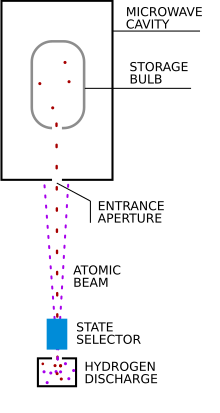
A hydrogen maser, also known as hydrogen frequency standard, is a specific type of maser that uses the intrinsic properties of the hydrogen atom to serve as a precision frequency reference.
YouTube Encyclopedic
-
1/3Views:1 88256423 139
-
Ancient Pyramids Produced Hydrogen on Colossal Scale with Microwave Energy
-
Lv84. PYRAMID POWER 6편! pyramid and hydrogen, plasma 피라밋과 수소,플라스마!!
-
MASER beams and MORE! - The Countdown #3
Transcription
Overview
Both the proton and electron of a hydrogen atom have spins. The atom has a higher energy if both are spinning in the same direction, and a lower energy if they spin in opposite directions. The amount of energy needed to reverse the spin of the electron is equivalent to a photon at the frequency of 1.420405751768 GHz,[1] which corresponds to the 21 cm line in the hydrogen spectrum.
Hydrogen masers are very complex devices and sell for as much as US$235,000.[2] There are two types to be distinguished: active and passive.
In both types, a small storage bottle of molecular hydrogen, H
2, leaks a controlled amount of gas into a discharge bulb. The molecules are dissociated in the discharge bulb into individual hydrogen atoms by an electric arc. This atomic hydrogen passes through a collimator then a magnetic state selector and into a storage bulb. The storage bulb is roughly 20 cm high and 10 cm in diameter and made of quartz internally coated with PTFE. Adsorption onto, chemical interaction with, and perturbation of atomic state by the bulb surface is much reduced. Consistent interactions with the bulb increase the quality of the oscillation. A durable PTFE and bulb coating technology allows for over 20-year lifetime.[3]
The storage bulb is inside a microwave cavity made from a precisely machined copper or silver-plated ceramic cylinder. This cavity is tuned to the 1.420 GHz resonance frequency of the atoms.[4] A weak static magnetic field is applied parallel to the cavity axis by a solenoid to lift the degeneracy of the magnetic Zeeman sublevels.[5] To decrease the influence of changing external magnetic fields on the transition line frequency and be compliant to electromagnetic interferences, the cavity is surrounded by several nested layers of shields.[3]
In the active hydrogen maser, the cavity oscillates by itself. This requires a higher hydrogen atom density and a higher quality factor for the cavity. With advanced microwave cavities made out of silver-plated ceramic, the gain factor can be much higher, thereby requiring less hydrogen atom density.[3] The active maser is more complex and more expensive but has better short-term and long-term frequency stabilities.
In the passive hydrogen maser, the cavity is fed from an external 1.420 GHz frequency. The external frequency is tuned to produce a maximum output in the cavity. This allows the use of lower hydrogen atom density and lower cavity quality factor, which reduces the cost.
-
An exposed hydrogen maser
-
A passive hydrogen maser used as a clock in Galileo satellite navigation system.
-
A hydrogen maser used by BeiDou-3
See also
References
- ^ "Time and Frequency from A to Z: H". Physics Laboratory. NIST. Hydrogen Maser. Retrieved 2010-04-06.
- ^ "MHM 2010 Active Hydrogen Maser Data Sheet" (PDF). Symmetricom. 2014. Retrieved 31 January 2016.
- ^ a b c "iMaser 3000". Archived from the original on 2010-03-23. Retrieved 2010-04-08.
- ^ "USNO, Hydrogen Masers". United States Naval Observatory. Archived from the original on 10 July 2006. Retrieved 31 January 2016.
The storage bulb is a quartz bulb about 20 cm tall which is coated inside with Teflon to control the recombination rate of atoms into molecules. The quartz bulb is located in a precisely machined pure copper cylinder which acts as a microwave resonant cavity for the 1.420 GHz frequency of the 21 cm hydrogen line. Once the atoms enter the resonance cavity, they find other atoms radiating and they fall in step. They "start to talk to each other" and echo what they hear. This produces a highly coherent oscillation. This is the signal to which the crystal oscillator is phase-locked. All of that is packaged in cabinets with power supplies, temperature control, and magnetic shielding.
- ^ US 5838206, "Active Hydrogen Maser Atomic Frequency Standard"
Bibliography
- Bauch, A. (2007). "Atomic frequency standards, properties and applications". In Hänsch, T.W.; Leschiutta, S.; Wallard, A.J. (eds.). Metrology and Fundamental Constants. Vol. Course CLXVI. Società Italiana di Fisica. Amsterdam: IOS Press. pp. 303–308. ISBN 978-1-58603-784-0. LCCN 2007934139. Retrieved 2010-04-08.
- Kleppner, D.; Goldenberg, H.M.; Ramsey, N.F. (1962). "The Atomic Hydrogen Maser". Physical Review. 126 (2): 603. Bibcode:1962PhRv..126..603K. doi:10.1103/PhysRev.126.603.
External links
- Hydrogen Maser Frequency Standard - Honeywell



